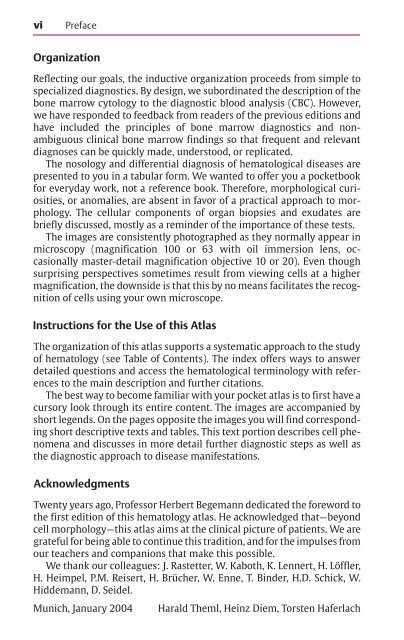Color Atlas of Hematology - Practical Microscopic and Clinical ...
Color Atlas of Hematology - Practical Microscopic and Clinical ...
Color Atlas of Hematology - Practical Microscopic and Clinical ...
- No tags were found...
You also want an ePaper? Increase the reach of your titles
YUMPU automatically turns print PDFs into web optimized ePapers that Google loves.
viPrefaceOrganizationReflecting our goals, the inductive organization proceeds from simple tospecialized diagnostics. By design, we subordinated the description <strong>of</strong> thebone marrow cytology to the diagnostic blood analysis (CBC). However,we have responded to feedback from readers <strong>of</strong> the previous editions <strong>and</strong>have included the principles <strong>of</strong> bone marrow diagnostics <strong>and</strong> nonambiguousclinical bone marrow findings so that frequent <strong>and</strong> relevantdiagnoses can be quickly made, understood, or replicated.The nosology <strong>and</strong> differential diagnosis <strong>of</strong> hematological diseases arepresented to you in a tabular form. We wanted to <strong>of</strong>fer you a pocketbookfor everyday work, not a reference book. Therefore, morphological curiosities,or anomalies, are absent in favor <strong>of</strong> a practical approach to morphology.The cellular components <strong>of</strong> organ biopsies <strong>and</strong> exudates arebriefly discussed, mostly as a reminder <strong>of</strong> the importance <strong>of</strong> these tests.The images are consistently photographed as they normally appear inmicroscopy (magnification 100 or 63 with oil immersion lens, occasionallymaster-detail magnification objective 10 or 20). Even thoughsurprising perspectives sometimes result from viewing cells at a highermagnification, the downside is that this by no means facilitates the recognition<strong>of</strong> cells using your own microscope.Instructions for the Use <strong>of</strong> this <strong>Atlas</strong>The organization <strong>of</strong> this atlas supports a systematic approach to the study<strong>of</strong> hematology (see Table <strong>of</strong> Contents). The index <strong>of</strong>fers ways to answerdetailed questions <strong>and</strong> access the hematological terminology with referencesto the main description <strong>and</strong> further citations.The best way to become familiar with your pocket atlas is to first have acursory look through its entire content. The images are accompanied byshort legends. On the pages opposite the images you will find correspondingshort descriptive texts <strong>and</strong> tables. This text portion describes cell phenomena<strong>and</strong> discusses in more detail further diagnostic steps as well asthe diagnostic approach to disease manifestations.AcknowledgmentsTwenty years ago, Pr<strong>of</strong>essor Herbert Begemann dedicated the foreword tothe first edition <strong>of</strong> this hematology atlas. He acknowledged that—beyondcell morphology—this atlas aims at the clinical picture <strong>of</strong> patients. We aregrateful for being able to continue this tradition, <strong>and</strong> for the impulses fromour teachers <strong>and</strong> companions that make this possible.We thank our colleagues: J. Rastetter, W. Kaboth, K. Lennert, H. Löffler,H. Heimpel, P.M. Reisert, H. Brücher, W. Enne, T. Binder, H.D. Schick, W.Hiddemann, D. Seidel.Munich, January 2004Harald Theml, Heinz Diem, Torsten Haferlach






